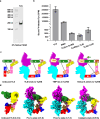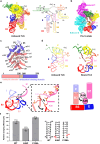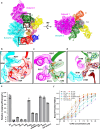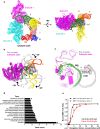Structural insights into dynamics of the BMV TLS aminoacylation
- PMID: 39900568
- PMCID: PMC11791061
- DOI: 10.1038/s41467-025-56612-4
Structural insights into dynamics of the BMV TLS aminoacylation
Abstract
Brome Mosaic Virus (BMV) utilizes a tRNA-like structure (TLS) within its 3' untranslated region to mimic host tRNA functions, aiding aminoacylation and viral replication. This study explores the structural dynamics of BMV TLS interacting with tyrosyl-tRNA synthetase (TyrRS) during aminoacylation. Using cryo-EM, we capture multiple states of the TLS-TyrRS complex, including unbound TLS, pre-1a, post-1a, and catalysis states, with resolutions of 4.6 Å, 3.5 Å, 3.7 Å, and 3.85 Å, respectively. These structural comparisons indicate dynamic changes in both TLS and TyrRS. Upon binding, TLS undergoes dynamic rearrangements, particularly with helices B3 and E pivoting, mediated by the unpaired A36 residue, ensuring effective recognition by TyrRS. The dynamic changes also include a more compact arrangement in the catalytic center of TyrRS and the insertion of 3' CCA end into the enzyme's active site, facilitating two-steps aminoacylation. Enzymatic assays further demonstrated the functional importance of TLS-TyrRS interactions, with mutations in key residues significantly impacting aminoacylation efficiency. Furthermore, Electrophoretic Mobility Shift Assay (EMSA) demonstrated that BMV TLS binds elongation factors EF1α and EF2, suggesting a multifaceted strategy to exploit host translational machinery. These findings not only enhance our knowledge of virus-host interactions but also offer potential targets for antiviral drug development.
© 2025. The Author(s).
Conflict of interest statement
Competing interests: The authors declare no competing interests.
Figures






Similar articles
-
A viral RNA hijacks host machinery using dynamic conformational changes of a tRNA-like structure.Science. 2021 Nov 19;374(6570):955-960. doi: 10.1126/science.abe8526. Epub 2021 Nov 18. Science. 2021. PMID: 34793227 Free PMC article.
-
Specific tyrosylation of the bulky tRNA-like structure of brome mosaic virus RNA relies solely on identity nucleotides present in its amino acid-accepting domain.J Mol Biol. 2001 Jun 1;309(2):387-99. doi: 10.1006/jmbi.2001.4654. J Mol Biol. 2001. PMID: 11371160
-
tRNA-like structure regulates translation of Brome mosaic virus RNA.J Virol. 2004 Apr;78(8):4003-10. doi: 10.1128/jvi.78.8.4003-4010.2004. J Virol. 2004. PMID: 15047816 Free PMC article.
-
Non-canonical substrates of aminoacyl-tRNA synthetases: the tRNA-like structure of brome mosaic virus genomic RNA.Biochimie. 1993;75(12):1143-57. doi: 10.1016/0300-9084(93)90014-j. Biochimie. 1993. PMID: 8199250 Review.
-
Evolution of the tRNA(Tyr)/TyrRS aminoacylation systems.Biochimie. 2005 Sep-Oct;87(9-10):873-83. doi: 10.1016/j.biochi.2005.03.008. Epub 2005 Apr 8. Biochimie. 2005. PMID: 16164994 Review.
References
-
- Kao, C. C. & Sivakumaran, K. Brome mosaic virus, good for an RNA virologist’s basic needs. Mol. Plant Pathol.1, 91–97 (2000). - PubMed
-
- Rao, A. L. N. & Cheng Kao, C. The brome mosaic virus 3’ untranslated sequence regulates RNA replication, recombination, and virion assembly. Virus Res.206, 46–52 (2015). - PubMed
-
- Matsuda, D. & Dreher, T. W. The tRNA-like structure of Turnip yellow mosaic virus RNA is a 3’-translational enhancer. Virology321, 36–46 (2004). - PubMed
MeSH terms
Substances
LinkOut - more resources
Full Text Sources

